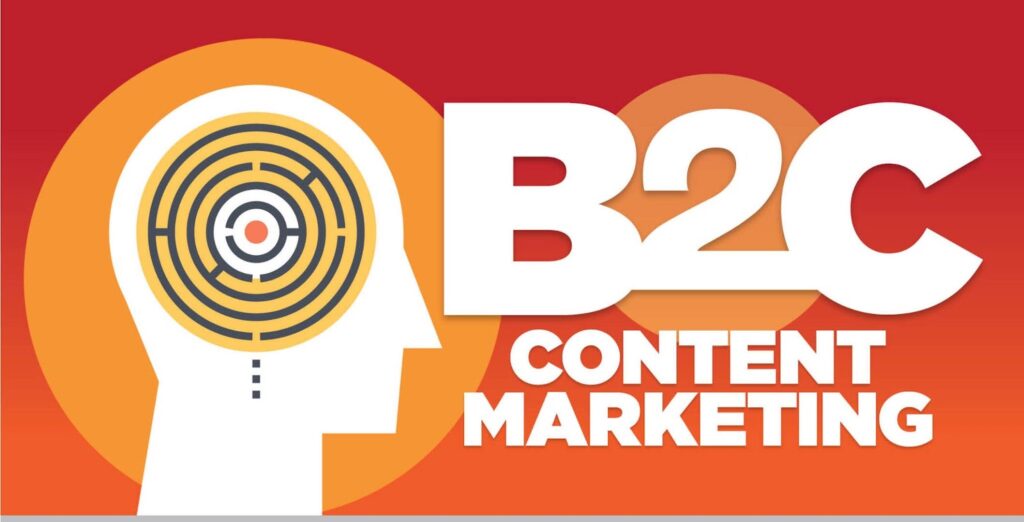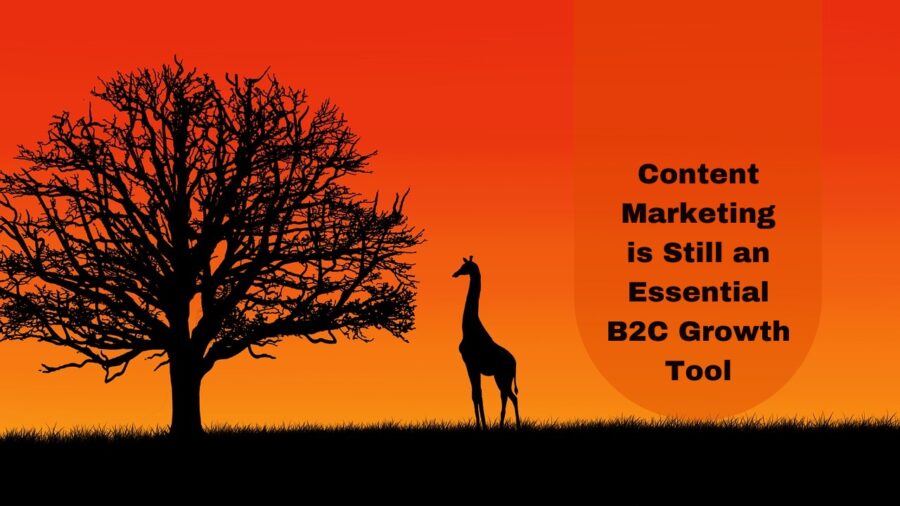Content marketing is an action plan for a marketing technique that focuses on creating and delivering valuable, relevant, and consistent content to attract and retain a specific audience – and, ultimately, to drive profitable consumer action.
The creation and distribution of relevant, valuable content to current and potential customers, such as blogs, newsletters, white papers, social media posts, emails, videos, and the like, is known as content marketing. When done correctly, this content demonstrates expertise and demonstrates that a company values the people to whom it sells.
Consistent use of content marketing helps to build and maintain relationships with current and potential customers. When your target audience sees your company as a partner who cares about their success and is a valuable source of information and guidance, they are more likely to choose you.

B2C Content Marketing
Without some form of marketing, no business-to-consumer (B2C) company could survive, let alone thrive. B2C marketing, which is distinct from business-to-business (B2B) marketing in that it is focused on promoting goods and services to individual consumers (rather than other organisations), is the magic that makes a company visible and appealing to its target audience. In other words, if you’re marketing directly to consumers, whether through your blog, corporate website, or online store, you need to understand how to effectively use content marketing.
It’s how you generate interest in your offering, acquire new customers (acquisition), retain existing customers (retention), increase sales, and turn your hard work into profit. It is, in many ways, a business’s lifeblood.
However, “doing” B2C marketing is not as straightforward as shouting from the rooftops about your new clothing line or mobile application. You must be aware of the person with whom you are speaking. You must familiarise yourself with the channels available to you. And, fortunately, there is now a plethora, thanks to digital transformation.
Online media Growth
The growth of online media and technologies has paved the way for a slew of new ways to engage customers — alternatives that enable increased personalization, interactivity, automation, and measurability. Consider social media marketing, email marketing, and video marketing, among other strategies.
Not only is content marketing a trendy buzzword, it is also an extremely effective marketing strategy. Marketing Sherpa increased their blog traffic by 232 percent through content marketing, and Buffer’s statistics show that publishing useful content on a consistent basis has a significant impact on the company’s finances.
With such success, it’s unsurprising that the Content Marketing Institute reports that “86% of B2C marketers use content marketing and 55% of B2C marketers intend to increase content marketing spending next year.”
We’ll discuss the B2C model, contrast B2B and B2C marketing, and look at some of the most effective B2C marketing channels. Additionally, we’ll discuss numerous tried-and-true tactics and strategies that business owners and marketing professionals can implement immediately to achieve results tomorrow. By the end, you should be well equipped to assist your business in not just surviving, but thriving.
Additionally, this comprehensive guide will demonstrate how to leverage content marketing to increase organic traffic, expand your reach to your target audience, and increase brand awareness.
What is Business-to-Consumer Content Marketing?
Business to consumer (B2C) content marketing encompasses the strategies and best practises for promoting products and services to consumers via the use of useful and engaging content.
According to a study published on Heidi Cohen’s blog, 37% of marketers agree that content marketing is effective at generating leads, building relationships, and increasing sales.
Before delving into the specifics of B2C marketing, it’s worth defining B2C in general. After all, you’ll need a firm grasp on this professional operating model in order to more effectively target your B2C marketing efforts more.
Broadly speaking, business-to-consumer (B2C) transactions and exchanges refer to commercial transactions and exchanges between businesses and individual consumers. B2C businesses sell their products and services directly to consumers for personal use, frequently through an online platform. The everyday consumer is ultimately what distinguishes business-to-consumer (B2C) enterprises from business-to-business (B2B) enterprises, which, as the name implies, focus on selling their wares to other businesses.
Apple, Tesco, Starbucks, Amazon, YouTube, and Lyft are just a few examples of successful business-to-consumer (B2C) transactions.
In contrast to businesses, end consumers frequently seek a specific solution to a known problem. B2C content marketing can assist in meeting those requirements and generating interest in your products.
Is inbound marketing synonymous with content marketing?
Inbound marketing refers to strategies that use high-quality content to attract prospects rather than push messages at them. Content marketing is critical to the success of any inbound marketing campaign.
Both inbound and content marketing are complementary. The most critical element you can use to capture and nurture leads, educate and cultivate prospects, generate interest in your business, and increase search traffic is content.
The Crucial Distinction Between Content and Inbound Marketing
The primary distinction between content marketing and inbound marketing is in the lead conversion methods used.
Content marketing is a subset of inbound marketing and is concerned with the creation of content for the purpose of communicating with the target audience.
Inbound marketing
Inbound marketing encompasses content marketing as well as other strategies, not all of which are communicated directly to the audience or to the entire audience.
Nonetheless, these terms can sound similar, especially given the degree of overlap. Thus, are content marketing and inbound marketing synonymous?
Is It Possible to Confuse the Terms “Content Marketing” and “Inbound Marketing“?
Simply put, no. However; bear with us.
Remember how you struggled in math class to comprehend how a square is a rectangle but a rectangle is not a square?
That, indeed, is the situation with “content marketing” and “inbound marketing.” To put it simply, content marketing IS inbound marketing, but not all inbound marketing is content marketing. Are you still perplexed?
Consider your entire inbound marketing strategy to be a restaurant menu, with content marketing serving as the main course’ section. There are other aspects of inbound marketing besides content marketing, but the content is the meat and potatoes.
Having said that, who doesn’t enjoy appetisers, desserts, and beverages? Yes, a comprehensive inbound marketing strategy entails more than content creation.
How Marketers should Think
“Marketers should think in terms of ‘and’ rather than ‘or’ when it comes to the content/inbound relationship. Both are critical to success. While content contributes to the fueling of your inbound engine, other equally valuable inbound projects — such as technical SEO, freemium trials, and interactive tools — may exist outside the scope of the content marketer, according to Hubspot, a leading inbound marketing software company.
In essence, while content marketing is a critical component of modern marketing success, businesses should not confine inbound marketing to content marketing alone.
Content Marketing Is Possibly the Most Important Aspect of Inbound Marketing
Having said that, content, as the meat and potatoes,is arguably the most critical component of inbound marketing. Businesses that consistently create engaging and useful content for their audience are off to a great start.
The other components of inbound marketing, such as SEO and advertising, will aid in the discovery of that golden content by the target audience, allowing them to join your company and begin telling others about it as well.
How Can I Effectively Use or Improve Content Marketing and Inbound Marketing? — Responsive Makes Marketing Simple
The nuances of inbound and content marketing are notoriously difficult to define, let alone implement, and industry best practices are constantly evolving.
The most practical solution for many businesses is to enlist the assistance of an inbound marketing team. With a little additional marketing muscle on your side, your business can more easily connect on new levels with your audience and fuel growth.
Responsive offers three tiers of inbound and content marketing services to assist businesses of all sizes in attracting, converting, and nurturing leads.
Begin with a complimentary assessment and discuss how we can collaborate to maximize your company’s inbound marketing strategy.

Recognize the B2C Customer
There are numerous advantages to businesses marketing directly to consumers, which may explain why businesses intend to increase their spending in this area over the next 12 months.
A B2C business generates revenue by catering to the needs and desires of everyday individuals. Numerous business models have emerged under the B2C umbrella over time, particularly as new digital technologies and platforms have enabled novel revenue streams.
Whichever B2C model your business follows, it is critical that you understand what it entails and the assumptions it makes in order to design an effective marketing campaign. Naturally, developing targeted messaging that resonates with your audience would be nearly impossible without a thorough understanding of what your customers value and how your company is structured to solve critical problems.
A significant advantage of B2C content marketing is that you communicate directly with consumers, eliminating the need for an intermediary. This results in a shorter sales cycle (more on this later). The final decision is usually made by the individual consumer, who uses both rational and emotional reasoning. Bear this in mind when creating content for your marketing efforts.
The majority of consumers are sophisticated, and they may not spend as much time thinking about your brand as you believe, as demonstrated by this cartoon from Marketoonist: That is why you must be strategic in your approach to enticing consumers to consider your brand by putting them first, speaking their language of value, and appealing to their emotions.
Emotions have the ability to increase customer lifetime value and long-term conversions.
The right emotional language can pique your prospects’ interests and persuade them to do business with you. There are numerous instances of this.
Stream Send, a provider of email marketing and social media delivery, uses emotional language to quickly connect with prospects and give them an impression of the benefits they will receive upon signing up.
MailChimp increased its customer base by 600 percent in a year after redesigning its website to make it more friendly and appealing. Additionally, two popular online retailers elicit a range of emotions from shoppers.
When creating B2C content, you must appeal to positive emotions and focus on the wants, needs, and feelings of your audience. That is the most effective method of overcoming objections.
Timing is critical.
According to the List, you must determine what triggers sales opportunities in order to reach out to prospects ahead of your competitors. That is entirely dependent on timing.
Alexander Osterwalder, a Swiss business theorist and consultant, developed a “business model canvas” to assist founders of both small startups and large enterprises in selecting the best model for their business, refining hypotheses about the operating structure of their company, and better understanding their value proposition.
He suggests the following questions (among others) to help you gain a better understanding of what makes your organisation tick (and thus your ability to market it effectively):
- Who are our most valuable clients?
- Which of our customers’ issues are we assisting in resolving?
- Who are our customers’ true willingness to pay?
- What do they pay for at the moment?
- Which are the critical activities that our value propositions necessitate?
- What critical resources are required to execute our value propositions?
- Which channels do our customer segments prefer?
- How are other businesses currently contacting them?
I frequently advise my readers to break stories and to keep an eye on the latest trends via Google and Twitter. When you do this, consumers begin to regard you as a source of useful information and develop a sense of trust for you and your brand.
It is critical to have the information, but also to understand when to share it. I recently published an infographic demonstrating that Wednesdays and weekends are the best days of the week for B2C engagements and click-through rates on social media. Additionally, if you want to increase your retweets, tweet around 5.00 pm.
Whether you’re marketing via email, blogging, or social media, all of these strategies rely on timing for success. According to Optimal Victory, Thursday is the day when more people open email than any other day of the week.
What are your audience’s objectives?
To be a successful B2C content marketer, you must first ascertain your audience’s preferences. Finding them is straightforward; the challenge is determining what keeps them awake and why they visit particular websites.
Allow me to simplify: all consumers seek solutions to their problems. Determine the nature of those issues and you can target your content marketing.
For instance, if you run an eCommerce site, Lab42’s research indicates that the majority of consumers prefer free shipping over a discount. Additionally, an American Express article demonstrates the importance of reviews to 81 percent of shoppers. That is valuable information for an online retailer.
How about other types of businesses? That is simple! To discover what consumers want, all you have to do is dig through the keywords they use to conduct their searches.
Here’s how to do it using the male undergarment industry example.
1: Visit Google AdWords Keyword Planner, Enter your desired keyword, scroll to the bottom, and click ‘go’.
2: Select the ‘keyword suggestions’ tab.
3: Select a keyword as the third step.
4: Enter your new keyword in the search box and click ‘Get Ideas.’ The long tail keyword results display precisely what your consumers are looking for.
What these findings indicate is the following:
Wearing an undergarment – The consumer wishes to learn which type of Undergarment will suit him.
Briefs, boxers, or trunks – The consumer desires either briefs or boxers, or trunks but essentially not trousers.
The consumer is only interested in either a bikini brief or see-through thongs, not a g-string.
When you understand what consumers desire, you can address their concerns through the creation of useful articles, tutorial videos, and infographics. That is the purpose of B2C content marketing.
Important Components of B2C Content Marketing

B2C content marketing’s ultimate goal is to generate leads, nurture them, and convert them into loyal and repeat customers. To accomplish this, you must adhere to the four Ps of marketing:
- Product
- Price
- Promotion
- Place
Success in business-to-consumer marketing requires developing emotional connections with consumers. And online commerce is exploding today. Thus, B2C commerce is synonymous with e-commerce — and if you want to build a best-of-breed e-commerce website, you must follow a few critical steps.
Similarly, Masterful Marketing details the essential components of a B2C content marketing campaign. Here’s how I see it fitting together:
1. Product-driven:
As a B2C content marketer, you cannot survive without a viable product. Whether your product is physical (such as a watch), downloadable (such as short reports, white papers, or e-books), or digital (such as software, plugins, or tools), you must promote a product that is relevant to your target consumer.
For instance, Darren Rowse’s Digital Photography School sells a variety of high-quality products aimed at assisting people in taking better digital photographs.
2. A sizable target market:
Emarketer predicted that B2C eCommerce sales would reach $1.7 trillion in 2015. This was because the number of online and mobile users was expected to grow. Due to the fact that there are more individual consumers than businesses, this is an excellent opportunity to reach a large number of people.
Zappos accomplishes this admirably, with a straightforward promise: when you purchase an item from their store, you qualify for free shipping and a 365-day return policy. Not only is this ingrained in the Zappos culture, but it is also a critical benefit for consumers, as it encourages future visits.
3. Analyse consumer’s thinking process:
To have a successful business-to-consumer marketing plan, you need to know how people make decisions. The latter half of these stages, which correspond to “research,” “discovery,” “product use,” and “repeated use,” respectively, can be influenced through your B2C marketing automation solution, which we’ll discuss in the final section.
4. Produce valuable content that converts:
Once you’ve figured out how consumers think when they’re shopping, the next step is to attract and convert them. Given that automation technology will relatively “level” the playing field within the next decade or so, as Jay Baer has discussed, the true differentiators will be (a) strategy and (b) your ability to create more compelling, attention-grabbing, and even educational content than anyone else.
Even the most advanced B2C marketing technology cannot save a brand that is fed subpar content (and data, which we will discuss as well). When it comes to content, B2C businesses’ top priorities include developing more interesting content, gaining clarity on what works, and creating inspirational visuals.
“The primary challenge for B2C marketers in the digital age is reaching and engaging their customers. Consumers seek content, entertainment, and social interaction. We are not seeking advertisements or interruptions. B2C marketers are battling to cut through the clutter.”
The most effective B2C strategies start with engaging content to connect and build relationships, which then results in conversions.
5. Conversion optimization and database development:
Finally, you must provide your machine/technology with high-quality, large-volume customer data. This task is most effectively accomplished through the use of valuable content to encourage contacts to opt-in to receive your communications, discounts, or e-newsletter.
Add a freebie as a bonus. By including a free offer (for content or a product), you can increase conversions and revenue more effectively than by discounting the same product. Occasionally, shoppers believe they are getting a better deal when they receive something for free rather than saving money on their overall purchase (via a coupon).
However, exercise caution with freebies and combine them with personalized, AI-driven incentives that are generated automatically and intelligently by machines to increase the likelihood of conversion on a one-to-one basis.
Successful B2C Marketing Campaigns Include the Following Elements
As we move forward in the “Age of the Customer,” successful B2C marketing strategies will incorporate three critical elements or characteristics: data-driven insights to inform smarter marketing, mobile as a critical component of an omnichannel approach, and marketing powered by artificial intelligence.
Utilizing data to gain a better understanding of your customer
When it comes to highly personalized content, business-to-consumer marketing strategies must be data-driven. It is the only way to determine what customers truly care about, their location, the type of content they will engage with, and the device or platform on which they will engage.
Harris-William says “The most critical and crucial component of a B2C marketing strategy is knowing your customer [through data analysis]. If you do not invest time in developing a deeper understanding of your customers’ pain, excitement, and interests, any tactic or ‘growth hack’ you attempt will be significantly less effective.”
Data-driven marketing is the process of using insights and metrics backed by data to improve communications and make educated guesses about how people will act in the future. One of the best ways to make sure that your marketing meets the personalization standards of today is to use data.
Ascertaining that your omnichannel strategy incorporates a robust mobile presence
Consumers are shopping more on their mobile devices than ever before, and the number continues to grow.
As a result, the practice of “showrooming” is gaining popularity.
What exactly is showrooming? When a customer showrooms, they browse products in a physical store while also frequently comparing prices online via their mobile device with other retailers.
84 percent of shoppers, for example, check prices on Amazon before shopping elsewhere.
Apart from showrooming, consumers are actively using their phones to perform other tasks while shopping. Consumers share 23% of social media updates and 19% check in with their location while in-store, according to data. 59 percent of all sessions on e-commerce websites occur on mobile devices (Smart Insights)!
Additionally, keep the following mobile-related tips in mind:
- Recognize the purposes of B2C applications. Consider why your app exists and how critical revenue generation is to you. Is your application a loyalty application, an e-commerce application, or a stand-alone application?
- Maintain a presence where your customers expect you to be. Millennials expect you to have a website, a mobile app that offers discounts (ideally), and social media pages that include a shopping feature (Facebook & Instagram mainly).
- Consider diversifying your mobile product portfolio and forming strategic partnerships. Competition for mobile apps is intensifying as a flood of commercial apps and new resellers emerge.
If your B2C brand wishes to compete, it must not only be present on mobile, but also excel at mobile marketing, focusing on the consumer experience via email, web browser, and in-app.

Confidence in AI to bolster your B2C marketing strategy
Artificial intelligence marketing, or AIM, is one of the most rapidly growing and highly anticipated capabilities in digital marketing.
AIM is revolutionizing marketing by delivering highly targeted, personalized consumer experiences at a fraction of the cost of traditional high-dollar campaigns. All of the data collected by brands can be segmented and analyzed in ways that are beyond the capabilities of humans using AIM solutions.
By enabling one-to-one, right-time, right-place communications with customers, AI marketing technology can significantly improve B2C marketing strategies.
Effective B2C Marketing Techniques
After discussing the overarching strategies and critical components of successful B2C brands, let’s dive into tactics and discuss how to actually acquire, retarget, and retain customers. While there is no real shortcut or secret to viral content or brand popularity — and nothing speaks louder than a high-quality product in B2C — there are certain elements you can implement immediately to accelerate growth.
Utilize your website as a marketing channel that generates value
Recent research from Ascend2 indicates that a brand’s website is its most effective marketing channel.
You, like every other B2C business, have a website. However, when was the last time you considered how you could leverage your website as a standalone, strategic, personalized marketing channel?
You can make your website your most valuable marketing tool by using B2C marketing technology.
Utilizing modal overlays to solicit opt-ins during entry or exit intent;
embedding custom messages within your website; and providing personalized incentives to known contacts based on CRM data.
To maximize the potential of a personalized website, marketers must leverage AI-enabled marketing automation technology to connect real-time session data and historical CRM customer data to enable hyper-personalized content.
PacSun, a well-known retailer, for example, uses a sticky banner with a personalised code and an exit-intent popup at the top of its website.
Pro Tip:
To increase opt-ins, include evidence of your legitimacy (like testimonials) Client testimonials can speak volumes for a B2C marketing strategy.
42% of online shoppers desire additional testimonials from e-commerce sites (Big Commerce). Andy Crestodina, a website marketing expert, believes that there is literally no limit to the number of testimonials that should be included on any given web page.
As a result, the requirements for the majority of B2C brands differ from those for B2B brands. Today’s B2C businesses are focused on three areas: customer acquisition, retention, and customer lifetime value (CLV). Automation enables each to scale, simplify, and expand.
Customer acquisition: When potential customers are considering making a purchase, marketing automation can benefit your B2C business in several ways:
- Sending messages at the optimal time for a contact to engage. This content is delivered at the optimal time to encourage engagement and action.
- Assuring that content is current and accurately reflects current inventory, conditions, and availability.
Retention: Marketing automation technology helps B2C brands keep customers by keeping one-time buyers from leaving and keeping them as loyal customers.
Automation contributes to retention in a variety of ways, including the following:
- Personalization — recommending products, automating the creation of custom content on your website, or displaying custom messages based on previous interactions with your brand
- Email marketing — ensuring that emails contain personalized content that increases engagement
- Cross-sell opportunities to assist customers throughout their journey.
Improve CLV
B2C-focused solutions are typically more adept at assisting brands in targeting consumers throughout their lives (as opposed to B2B).
The three keys to increasing CLV (customer lifetime value) in B2C are to sell an excellent product, provide an excellent experience, and provide ongoing assistance/value to customers.
Personalization, when combined with the acquisition and retention capabilities of B2C-focused solutions, helps ensure a customer’s loyalty. Customers who are loyal stay longer, interact more frequently, and spend more.
Choosing the most appropriate B2C marketing automation solution
Where should you begin when it comes to identifying your challenges and implementing a B2C solution to address them?
Are we addressing the correct issue? Do we require AI-enabled technology to assist our e-commerce efforts — and what if we choose the incorrect technology? How can we forecast and demonstrate the expected outcomes/return on investment (ROI) of a machine? And does the risk of adoption outweigh the unknown? Then, what preparations must be made for implementation? How long will it take, how much will it cost, how will it be used by end-users, and how will it benefit our customers?
Choosing a marketing automation solution can quickly become a lengthy, drawn-out process — and the larger the business, the more complicated the process can become.
Regardless, there are several factors that any B2C brand should consider, starting with identifying your own needs and those of your customers and then exploring options.
When selecting a new marketing platform, the following five questions should be asked:
1 Is the platform capable of achieving your goals and objectives?
You must address this most critical question (usually achieved with an RFP). Choose a platform that will assist you in meeting and exceeding your objectives.
2 In what ways can the platform assist in resolving current or future challenges?
You don’t want to choose a marketing platform that will become obsolete in a few years due to technological advancements. Ascertain that your investment will also address future challenges. With advancements in computer science, machine learning, and artificial intelligence – and their application in retail and e-commerce – select a solution that incorporates these capabilities to assist in automating more and more processes down the road.

3 How have similar-minded marketing teams accessed and utilised this platform?
Your team is not alone in its pursuit of the ideal fit. How have similar organisations gone about finding the right platform, why did they choose the solution they did, and what successes or setbacks did they encounter during adoption?
4 Is this platform capable of effectively managing our customer data?
Your most valuable asset is your data. How will consumer data from a variety of sources be gathered and stored in this new platform? How will this data be accessed and used by end users? And how can your team derive actionable metrics from this aggregated data?
5 How will the implementation and ongoing use be handled once we make the purchase?
After the deal is signed, what are the next steps in terms of onboarding, implementation, anticipated outcomes, and account management throughout the account’s lifecycle? Choose an option that is simple and straightforward.
Thousands of marketing-related tools are available, as are dozens and dozens of viable automation engines. However, the list becomes more manageable when limited to omnichannel, AI-infused personalization engines.
Final Remarks
Whether you’re an experienced content marketer or are just getting started with determining which content marketing strategy to incorporate into your campaign, you now understand how to connect with your customers through targeted B2C content. Utilize a combination of articles, blog posts, videos, infographics, and podcasts to maximise it, which Blue Glass refers to as a “multi-channel content marketing strategy.”
This will assist you in increasing engagement and nurturing relationships, regardless of where your target audience is located.







Pingback: Content writing services in India is best done by Eastside Writers
Pingback: 16 Best Indian Content Writing Services and Platforms in 2023